Does Fish Also Need to Rest After Cooking?
A few weeks ago we talked about resting meat after cooking (steaks in particular). Today let’s look at fish—does it also need to rest after cooking?
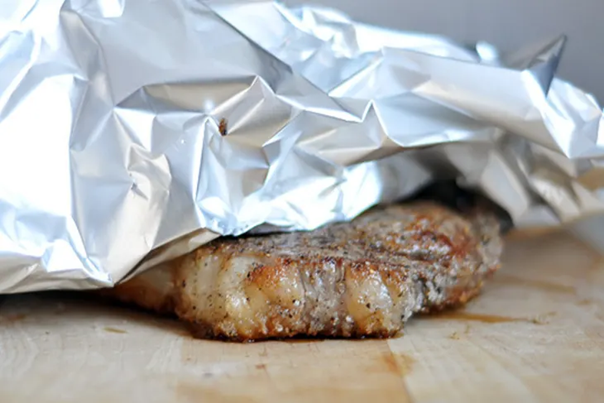
According to Caren White, one of America’s Test Kitchen experts, “Meat should always be rested, but fish plays by its own rules. There are a few variables.”
Caren explains that fish simply doesn’t need the long, slow rest of other meats. If anything, the rest should be proportional to cook time and dependent on the variety of fish.
“Fish with a higher fat content and more connective tissue, for instance, can tolerate a 5- to 10-minute covered- or sauced-resting period. Most other fish, such as cod, will dry out and even lose liquid while resting.
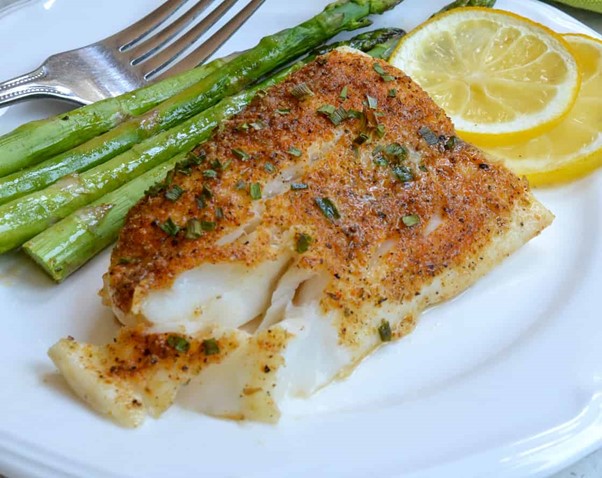
“Typically, carryover for fish is a mere 5-degree difference on an already lower cooking temperature (135 degrees F). Too long of a rest and the fish will cool down past a comfortable eating temperature.”
So a good rule of thumb? If the recipe doesn’t call for a rest, skip it.
However, here’s a short summation, a little tutorial that Caren shared with the Test Kitchen readers that we’ll all appreciate:
WHAT TYPES OF FISH CAN YOU SUCCESSFULLY REST AFTER COOKING?
Firm-fleshed white fish with a dense, meaty texture can rest for a short period to improve texture (such as pan-roasted monkfish). Fattier fish like salmon can cook for an extended period of time and can tolerate a rest of 5–10 minutes.
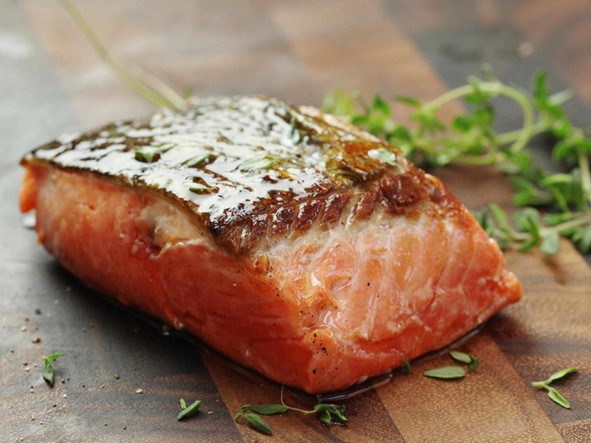
WHAT TYPES OF FISH SHOULD NOT BE RESTED AFTER COOKING? (Consider carryover cooking when it comes to fish that should not be rested.)
Lean white fish does not have enough connective tissue to remain intact. For example, if you let a cod fillet sit, it will start to flake apart and cool down faster.
Tuna steaks are seared and ideally raw in the center. If you let a rare tuna steak rest, it will be overcooked.
Thin fillets (like tilapia) cool quickly. Eat these types of fish right away to ensure they don't get cold—they’re just not that great once they’ve gotten cold.
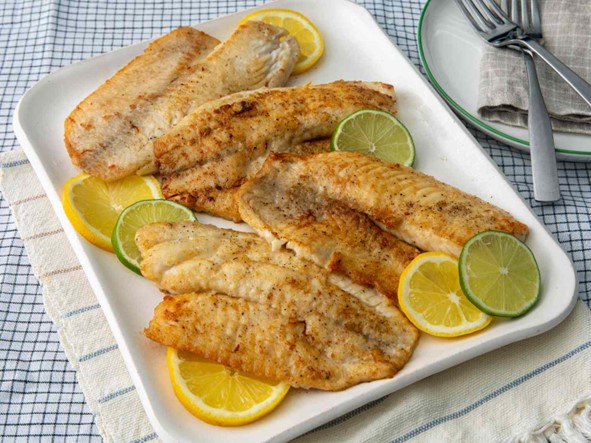
This is helpful information to know, because according to the American Heart Association, it should be eaten at least two times per week as part of a healthy diet. It’s a good alternative to red meat as it comes with several health benefits. For instance: Fish is filled with omega-3 fatty acids and vitamins such as D and B2 (riboflavin). And it’s rich in calcium and phosphorus. It’s also a great source of minerals, such as iron, zinc, iodine, magnesium, and potassium.
The above information should ensure we turn out a tastier fish dish. And speaking of a tasty fish dish, here’s one of America’s Test Kitchen’s favorite fish recipes. It was created a few years ago by another of the Test Kitchen experts, Steve Dunn. And it’s stood the test of time. Try this and see what you think.
Before you begin, it’s good to know that you can substitute red snapper or haddock for the cod. The “skinned” side of a skinless fillet can be identified by its streaky, slightly darker appearance.
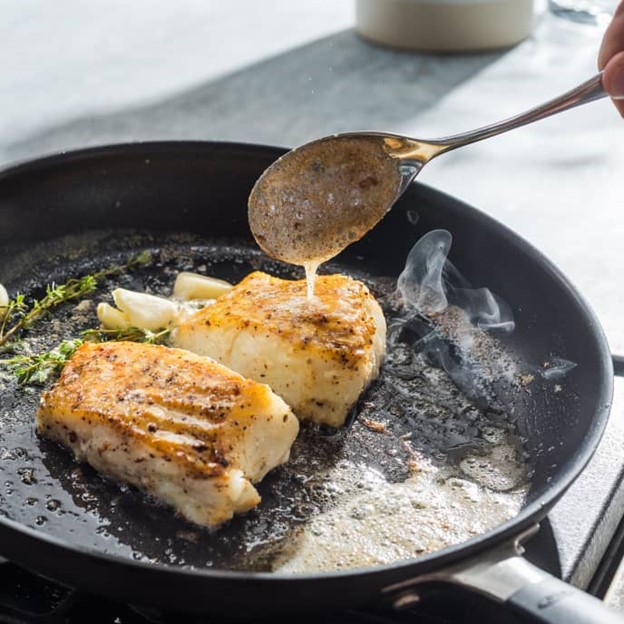
2 6 ounce skinless cod filets about 1-inch thick
1/2 teaspoon kosher salt
1/6 teaspoon pepper
1 tablespoon extra virgin olive oil
3 tablespoons unsalted butter cut into ½-inch cubes
2 cloves garlic crushed and peeled
4 sprigs fresh thyme
lemon wedges
Directions:
Add Recipe to Cook'n

According to Caren White, one of America’s Test Kitchen experts, “Meat should always be rested, but fish plays by its own rules. There are a few variables.”
Caren explains that fish simply doesn’t need the long, slow rest of other meats. If anything, the rest should be proportional to cook time and dependent on the variety of fish.
“Fish with a higher fat content and more connective tissue, for instance, can tolerate a 5- to 10-minute covered- or sauced-resting period. Most other fish, such as cod, will dry out and even lose liquid while resting.

“Typically, carryover for fish is a mere 5-degree difference on an already lower cooking temperature (135 degrees F). Too long of a rest and the fish will cool down past a comfortable eating temperature.”
So a good rule of thumb? If the recipe doesn’t call for a rest, skip it.
However, here’s a short summation, a little tutorial that Caren shared with the Test Kitchen readers that we’ll all appreciate:
WHAT TYPES OF FISH CAN YOU SUCCESSFULLY REST AFTER COOKING?
Firm-fleshed white fish with a dense, meaty texture can rest for a short period to improve texture (such as pan-roasted monkfish). Fattier fish like salmon can cook for an extended period of time and can tolerate a rest of 5–10 minutes.

WHAT TYPES OF FISH SHOULD NOT BE RESTED AFTER COOKING? (Consider carryover cooking when it comes to fish that should not be rested.)
Lean white fish does not have enough connective tissue to remain intact. For example, if you let a cod fillet sit, it will start to flake apart and cool down faster.
Tuna steaks are seared and ideally raw in the center. If you let a rare tuna steak rest, it will be overcooked.
Thin fillets (like tilapia) cool quickly. Eat these types of fish right away to ensure they don't get cold—they’re just not that great once they’ve gotten cold.

This is helpful information to know, because according to the American Heart Association, it should be eaten at least two times per week as part of a healthy diet. It’s a good alternative to red meat as it comes with several health benefits. For instance: Fish is filled with omega-3 fatty acids and vitamins such as D and B2 (riboflavin). And it’s rich in calcium and phosphorus. It’s also a great source of minerals, such as iron, zinc, iodine, magnesium, and potassium.
The above information should ensure we turn out a tastier fish dish. And speaking of a tasty fish dish, here’s one of America’s Test Kitchen’s favorite fish recipes. It was created a few years ago by another of the Test Kitchen experts, Steve Dunn. And it’s stood the test of time. Try this and see what you think.
Before you begin, it’s good to know that you can substitute red snapper or haddock for the cod. The “skinned” side of a skinless fillet can be identified by its streaky, slightly darker appearance.

Butter-Basted Fish Fillets with Garlic and Thyme
Ingredients:
2 6 ounce skinless cod filets about 1-inch thick
1/2 teaspoon kosher salt
1/6 teaspoon pepper
1 tablespoon extra virgin olive oil
3 tablespoons unsalted butter cut into ½-inch cubes
2 cloves garlic crushed and peeled
4 sprigs fresh thyme
lemon wedges
Directions:
1. Pat all sides of fillets dry with paper towels. Sprinkle on all sides with salt and pepper. Heat oil in 12-inch nonstick or carbon-steel skillet over medium-high heat until just smoking.
2. Reduce heat to medium and place fillets skinned side down in skillet. Gently press on each fillet with spatula for 5 seconds to ensure good contact with skillet. Cook fillets, without moving them, until underside is light golden brown, 4 to 5 minutes.
3. Using 2 spatulas, gently flip fillets. Cook for 1 minute. Scatter butter around fillets. When butter is melted, tilt skillet slightly toward you so butter pools at front of skillet. Using large spoon, scoop up melted butter and pour over fillets repeatedly for 15 seconds. Place skillet flat on burner and continue to cook 30 seconds longer. Tilt skillet and baste for 15 seconds. Place skillet flat on burner and take temperature of thickest part of each fillet. Continue to alternate basting and cooking until fillets register 130 degrees.
4. Add garlic and thyme sprigs to skillet at 12 o'clock position (butter will spatter). When spattering has subsided, continue basting and cooking until fillets register 140 degrees at thickest point. (Total cooking time will range from 8 to 10 minutes.)
5. Transfer fillets to individual plates. Discard garlic. Top each fillet with thyme sprigs, pour butter over fillets, and serve with lemon wedges.
2. Reduce heat to medium and place fillets skinned side down in skillet. Gently press on each fillet with spatula for 5 seconds to ensure good contact with skillet. Cook fillets, without moving them, until underside is light golden brown, 4 to 5 minutes.
3. Using 2 spatulas, gently flip fillets. Cook for 1 minute. Scatter butter around fillets. When butter is melted, tilt skillet slightly toward you so butter pools at front of skillet. Using large spoon, scoop up melted butter and pour over fillets repeatedly for 15 seconds. Place skillet flat on burner and continue to cook 30 seconds longer. Tilt skillet and baste for 15 seconds. Place skillet flat on burner and take temperature of thickest part of each fillet. Continue to alternate basting and cooking until fillets register 130 degrees.
4. Add garlic and thyme sprigs to skillet at 12 o'clock position (butter will spatter). When spattering has subsided, continue basting and cooking until fillets register 140 degrees at thickest point. (Total cooking time will range from 8 to 10 minutes.)
5. Transfer fillets to individual plates. Discard garlic. Top each fillet with thyme sprigs, pour butter over fillets, and serve with lemon wedges.
Recipe formatted with the Cook'n Recipe Software from DVO Enterprises.
 Alice Osborne
Alice Osborne
Weekly Newsletter Contributor since 2006
Email the author! alice@dvo.com
